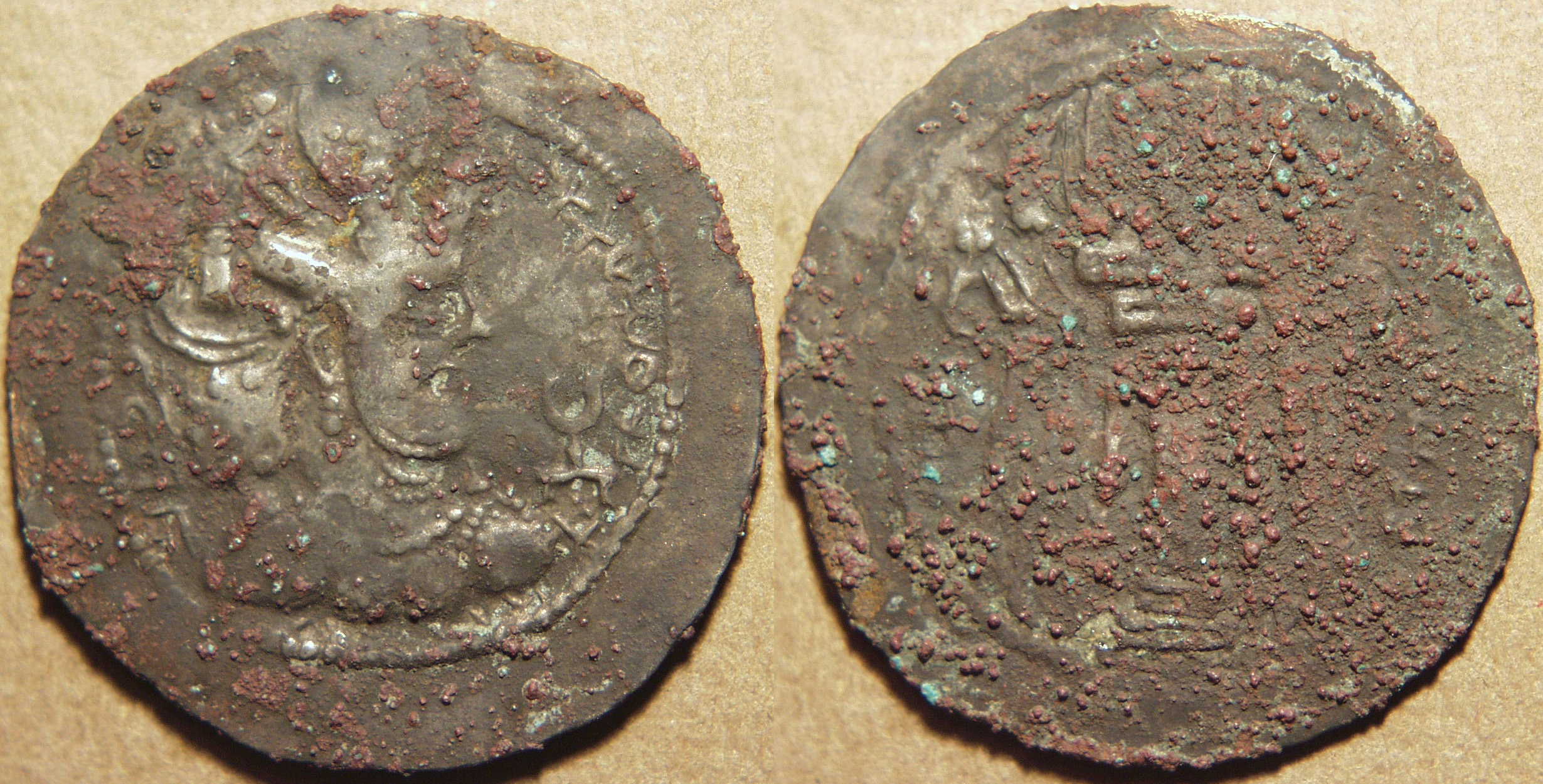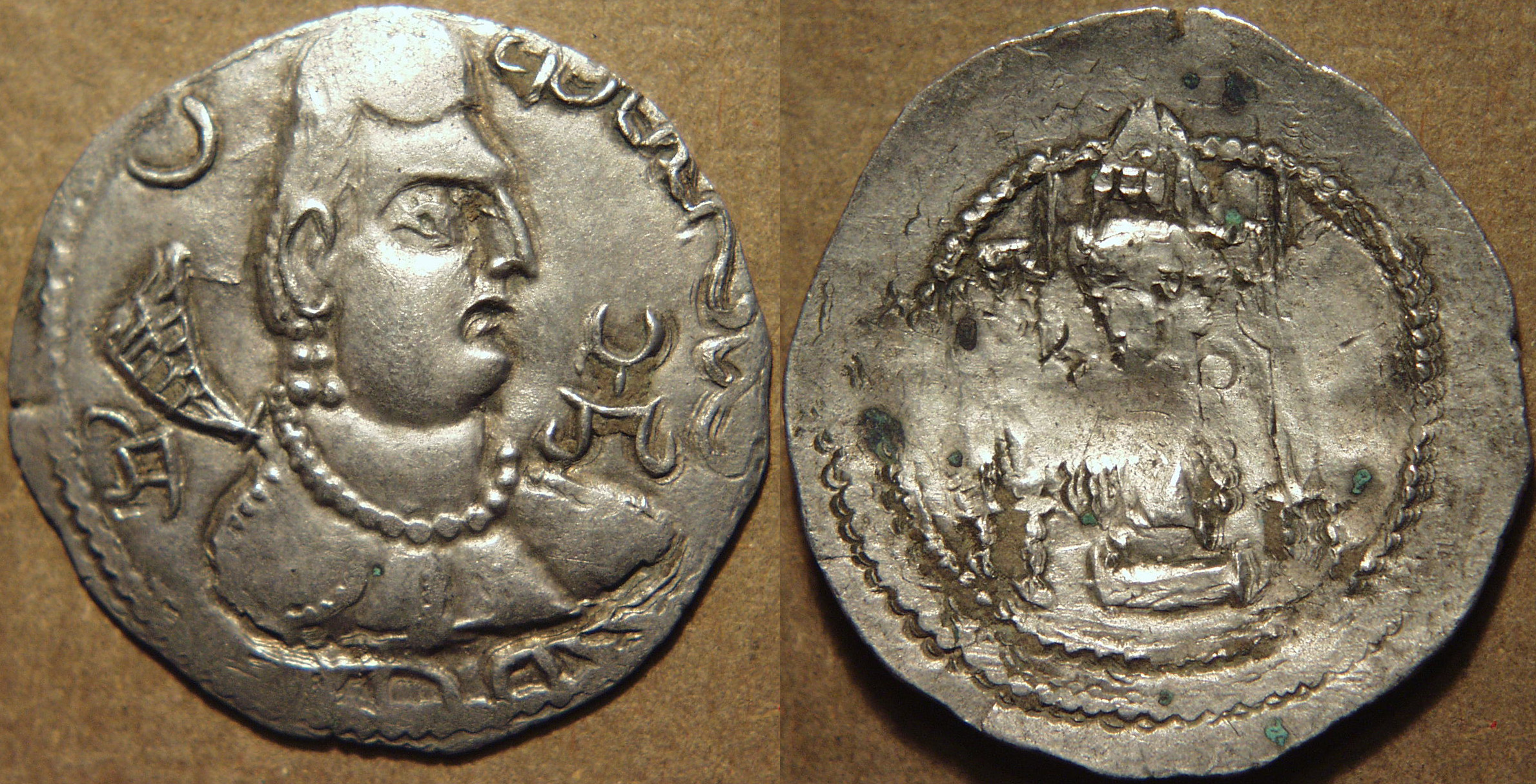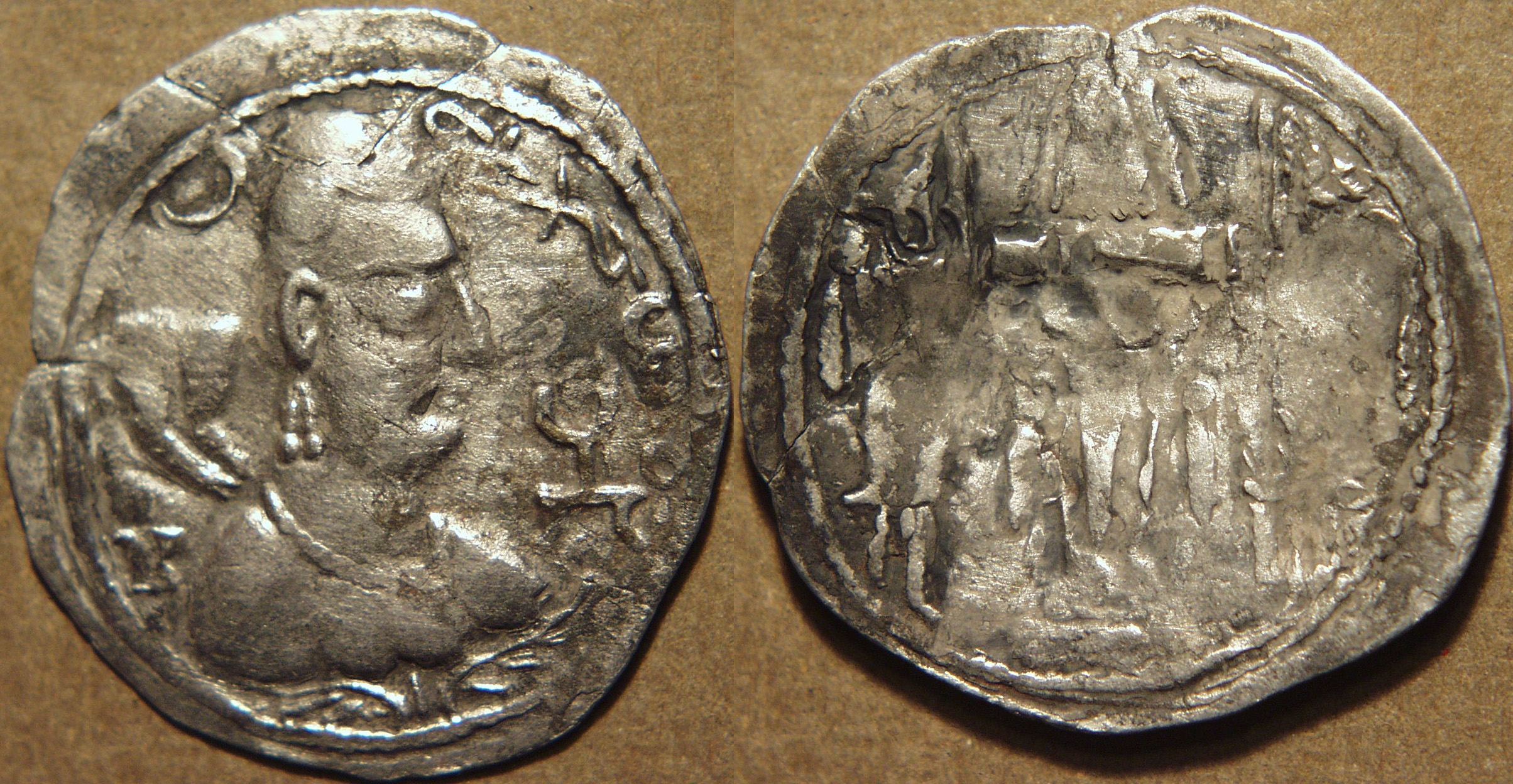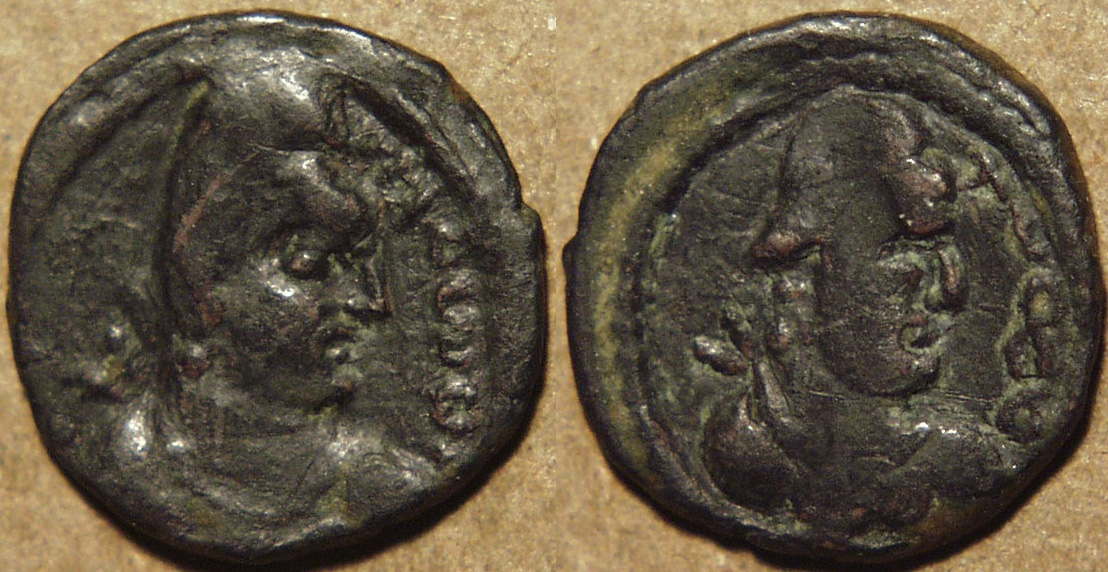
|
Our knowledge of the various Hunnic tribes is still quite uncertain but is evolving. In his seminal four-volume study of Hunnic coins (Dokumente zur
Geschichte der Iranischen Hunnen in Baktrien und Indien), Robert Göbl identified four major series of coins and divided them into four separate
"tribes" or phases: the Kidarites, the Alchon Huns, the Nezak Huns and the "proper" Hephthalites. Certainly these four major groupings seem logical based on
style and typology, so numismatists continue to use them.
The earliest coins of the Alchon Huns seem to date from very late in the fourth century, as they actually use dies of the Sasanian emperor Shapur II (ruled 309-
379), recut to reflect their name (Alchono) and their symbol: the so-called "bull" tamgha. Subsequently, they cut fresh dies of this type and the first coin
shown below is one of these, with the bull tamgha in the right field of the obverse. What followed is a matter of some dispute, and I will discuss the issues as I
present the coins.
A key development in our knowledge of these coins came in 2006. In his study, Göbl had not made much progress in creating a sequence for the
coins, as they just didn't seem to follow a pattern. In 2006, Gudrun Melzer published a reading and translation of a copper scroll inscription from the Schøyen
collection that fundamentally
changed the outlook. In this inscription, four separate kings who we know from the coins are named as donors in the establishment of a Buddhist stupa. So we
now realize that these four kings: Khingila, Toramana, Javukha and Mehama, were all ruling at the same time and therefore were issuing coins in parallel.
No wonder the coins didn't seem to follow a logical sequence! More details will emerge in the ensuing discussion.
This page presents the anonymous coins of the early Alchons, and then, on succeeding pages, I will present what seem to me to be the logical four series
that might have followed these coins, centering on the four kings mentioned in the Schøyen copper scroll inscription published by Melzer. To see the
whole discussion, simply click on the Next button at the end of each of these pages.
|
 |
Early Alchon Coins |

|
Imitation Shapur II silver drachm
Crowned bust of king right, "bull" tamgha before,
Bactrian legend at right: alchono /
Fire altar, flanked by armed attendants
Weight: 4.15 gm, Diameter: 30 mm., Die axis: 3 o'clock
Ref: Göbl 36
|
 |
This rare type features the first freshly cut dies imitating the coinage of Shapur II. Apart from the
tribal name alchono in Bactrian script, it features the "bull" tamgha which seems to have been a key symbol of the tribe. Göbl argued that
the tamgha shows the horns of a bull mounted on a stand. Most, but not all, Alchon coins carry it. I personally do not find this identification persuasive;
instead, I believe the tamgha represents a lunar crescent on a stand. As we will see, the lunar crescent became the chief ornament on Alchon
crowns, so clearly this symbol was an important one for them.
|
 |
 |
 |
Anonymous Coins with Alchon Bust |

|
Anonymous silver drachm, c. late 4th or early 5th century
Bare-headed bust of king right, wearing pearl necklace with double ribbons,
"bull" tamgha before, crescent moon above left,
Brahmi letter tha? at left, Bactrian legend at right: alchono /
Fire altar, flanked by armed attendants
Weight: 3.84 gm, Diameter: 30 mm., Die axis: 3 o'clock
Ref: Göbl 41
|
 |
The next phase of Alchon coinage was still anonymous, naming only the clan "Alchon," but now
featuring a distinctly Alchon bust with a tall head representing the skull deformation practiced by the tribe. The bust was not crowned and so there was no diadem
with its trailing ribbon ends. Instead, the bust is shown wearing a necklace with trailing ribbons. This may be an indication that the die cutters misunderstood
the Sasanian drachms on which these coins were based ... on the Sasanian coins, the king always wore a diadem with trailing ribbbons, but there was normally
a large hair bun behind the head and the ribbons floated above this. It was sometimes unclear where the ribbons were attached and the Alchon celators may
have thought it was at the necklace.
This coin has an interesting feature. If you look carefully (click on the image for an enlargement), you can see that the ribbon ends have been carved twice. At first,
they were more vertical and right up against the left border of the coin and probably continuing up beyond where the crescent is now. My guess is that the die cutter
first forgot to leave space for the crescent and had to recut the ribbons in order to make room for it. Alternatively, the coin was first designed without a crescent and
the crescent was a later addition. Among all known coins of this period, however, none has lacked the crescent, so the first explanation is the more likely one.
|

|
Anonymous silver drachm, c. late 4th or early 5th century
Bare-headed bust of king right, wearing pearl necklace with double ribbons,
"bull" tamgha before, crescent moon above left,
Brahmi letter shi (sri?) at left, Bactrian legend at right: alchono /
Fire altar, flanked by armed attendants
Weight: 3.53 gm, Diameter: 29 mm., Die axis: 3 o'clock
Ref: Göbl 43
|
 |
This coin shows the same sort of ribbon ends as the previous coin, but a different Brahmi letter behind the
king's bust ... perhaps shi and intended to be sri. Many Hun coins from Sind feature a prominent sri on them.
|

|
Anonymous silver drachm, c. late 4th or early 5th century
Bare-headed bust of king right, wearing pearl necklace with double ribbons,
"bull" tamgha before, crescent moon above left,
Brahmi letter shi (sri?) at left, Bactrian legend at right: alchono /
Fire altar, flanked by armed attendants
Weight: 3.63 gm, Diameter: 27.5 mm., Die axis: 3 o'clock
Ref: Göbl 43
|
 |
Göbl doesn't distinguish between this coin and the previous one, but the depiction of the ribbon ends is
distinctly different: here the ribbon ends are kept separate and arranged vertically as narrow cylinders as opposed to the previous two coins where the ribbon ends
are almost joined together to form a triangular shape. What exactly is the significance of this difference is not clear. They are not clearly separated in time as coins of
the Sasanian kings of the late 4th and early 5th centuries show both of these ribbon ends. They at least represent the hand of different die cutters, and perhaps of
different mints.
|

|
Anonymous silver drachm, c. late 4th or early 5th century
Bare-headed bust of king right, wearing pearl necklace with double ribbons,
"bull" tamgha before, crescent moon above left,
Brahmi letter ma ? at left, Bactrian legend at right: alchono /
Fire altar, flanked by armed attendants
Weight: 3.11 gm, Diameter: 28 mm., Die axis: 3 o'clock
Ref: Göbl 43 var
|
 |
An unpublished variety of the previous coin, with the Brahmi letter ma behind the king's head. The
significance of these letters is not known.
|

|
Anonymous copper unit, c. late 4th or early 5th century
Bare-headed bust of king right, wearing pearl necklace with double ribbons,
Bactrian legend at right: alchono /
Helmeted ? bust of king right, wearing pearl necklace with double ribbons,
Bactrian legend at right: alchono /
Weight: 1.11 gm, Diameter: 13 mm., Die axis: 12 o'clock
Ref: Göbl 45
|
 |
The anonymous series of Alchon coins included some rare copper coins as well. These were very unusual
in that there was a bust on both sides. One thing we learn from these coins is that the Hun mint masters were perfectly capable of minting coins with clear designs
on both sides ... why their silver coins always had obliterated reverses remains a mystery.
|
|
|